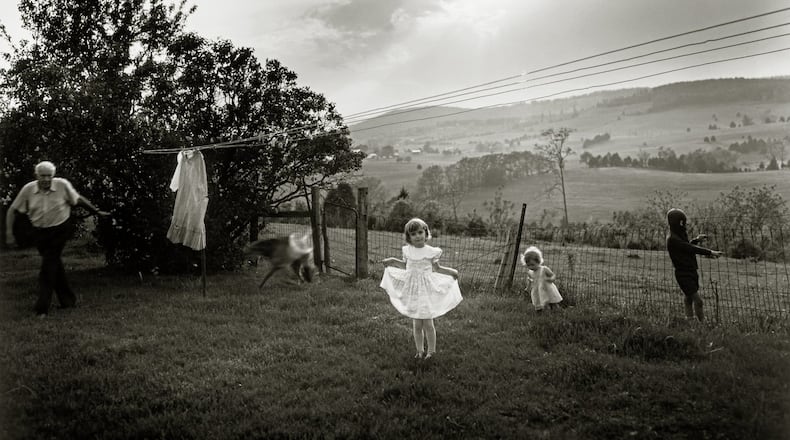Naked children gamboling like wood sprites on a riverbank. Chiaroscuro landscapes of battlefields and swamps. Abandoned churches, their faded clapboards choked by vines. Studies of a middle-aged man’s body in decline. These are some of the images — many of them pocked and blurred from using antiquated equipment and processes — featured in “Sally Mann: A Thousand Crossings,” the first major touring exhibition of the 68-year-old photographer, whose work is deeply rooted in the South.
Making its final stop on a six-city tour, the exhibition opens at the High Museum on Oct. 19, and it is something of a homecoming for Sarah Kennel, who co-curated the show before joining the High Museum's staff as curator of photography in July.
A California native, Kennel spent four years working with Mann, Mann’s assistant Molly Smith and co-curator Sarah Greenough to organize the show, which debuted in March 2018 at the National Gallery of Art in Washington, D.C. Subsequent shows were held in Salem, Massachusetts, Los Angeles, Houston and Paris.
But Kennel’s connection to the show is not the only bit of symmetry surrounding the exhibition.
“I’m particularly excited to bring the show to Atlanta,” said Kennel, “because the High awarded Sally the ‘Picturing the South’ commission in 1996, which was really transformative for her career.”
“Picturing the South” launched in 1996 with an exhibition of 160 photographs documenting life in the South that included work by Mann. But it’s more than a single exhibition, it is a continuing program that commissions new work for the High’s permanent photography collection. Mann received the program’s inaugural commission, for which she produced four landscapes.
“Sally was just beginning to transition from photographing her family to photographing the Southern landscape and experimenting with alternative photographic processes,” explained Gregory Harris, associate curator of photography at the High. “She shot on Ortho (high-contrast) film for the commission. She had not yet begun working with wet plate collodion as she would for most of the later landscapes.” (Wet plate collodion is a 19th-century process that involves a glass plate and a portable darkroom.)
A 25-year retrospective of commissions from “Picturing the South” will be presented at the High in 2021.
The seed for “A Thousand Crossings” was planted when the Corcoran Gallery shuttered in 2014 and began dispersing its collection. Many of its works, including works by Mann, went to the National Gallery of Art, where Kennel was a photography curator at the time.
“I realized when they came under the stewardship of the National Gallery that the institution at that point had, I think, the largest institutional holdings of Sally’s work. Given how important she is as an artist, that surprised and intrigued me,” said Kennel. “Then I began to dig a little deeper and realized that despite her fame and the enduring power of her work, there hadn’t been a really major touring show. That was the beginning.”
Among the 116 images on view in “A Thousand Crossings,” 53 have never been exhibited before.
Concurrently with the High's show, Jackson Fine Art in Buckhead is also showing Mann's work, including select Southern landscapes and "Remembered Light," her 2016 series of artist Cy Twombly and his Virginia studio. The show opens Oct. 17 with an artist's reception, which Mann is expected to attend.
Mann first garnered national attention in the early ‘90s when she was living off the grid in a remote part of Virginia in a house she and her attorney husband built on a farm. There they raised three children without benefit of electricity and running water. Immersed in a life of domesticity, Mann merged her artistic expression with subjects most intimate to her: Jessie, Emmett and Virginia, her children.
In Chicago, she debuted “Immediate Family,” a gallery show of ethereal, mostly black-and-white photographs of her children sleeping, playing, eating and suffering youthful injuries like bug bites and a bloody nose. In some of the images, the children were depicted without clothing. A photography book soon followed, which triggered a public backlash against the nude photographs. Editorials criticized Mann’s parenting. TV preachers condemned her morals. Critics defended her artistic vision. And sales were brisk.
Nearly 30 years later, some of those same images appear in “Family,” the first section of the five-part retrospective at the High. Subsequent sections include “The Land,” featuring images of lush summer foliage, swollen rivers and the site where lynching victim Emmett Till’s mutilated body was found. In “Last Measure” are images of Civil War battlefields and trenches so dark they’re nearly all black. “Abide With Me” weaves together a variety of subjects that more deeply explore the topic of race — swamps where escaped slaves hid on their journey north, wooden churches, portraits of black men and a series of images that pair Mann’s daughter Virginia as a young child with her namesake, Virginia Carter, an African American woman who was employed by Mann’s parents as a domestic worker for decades.
The final section, “What Remains,” features newer, haunting family images — hyper-close portraits of Mann’s adult children — one of whom, Emmett, had schizophrenia and killed himself three years ago at age 36 — and images of the arm, torso, back and haunch of Mann’s husband, whose body is battling muscular dystrophy. The last section is a powerful bookend to the youthful bodies and free-spirited promise of the first section, and a sobering reminder of our temporary status on Earth.
“One of the things that is so compelling about her photography is that she manages to address really wide universal themes — love and loss, history, death — all of these transcendent concerns, but she does it through a personal and intimate lens, and it’s very hard to do that,” said Kennel. “I think when an artist manages to do that and you feel individually touched — but you’re part of a larger narrative — it can be very moving. At the end of the day, art can do many, many things, but if it can touch us and make us think about our own lives and how we’re connected, that’s a pretty amazing thing.”
ART PREVIEW
"Sally Mann: A Thousand Crossings."Oct. 19-Feb. 2. $14.50. High Museum of Art, 1280 Peachtree St., Atlanta. 404-733-4400, high.org.
"Remembered Light & Landscapes."Oct. 17-Dec. 21. Free. Artist's reception 6-8 p.m. Oct. 17. Jackson Fine Art, 3115 E. Shadowlawn Ave., Atlanta. 404-233-3739, jacksonfineart.com.
About the Author
Keep Reading
The Latest
Featured






